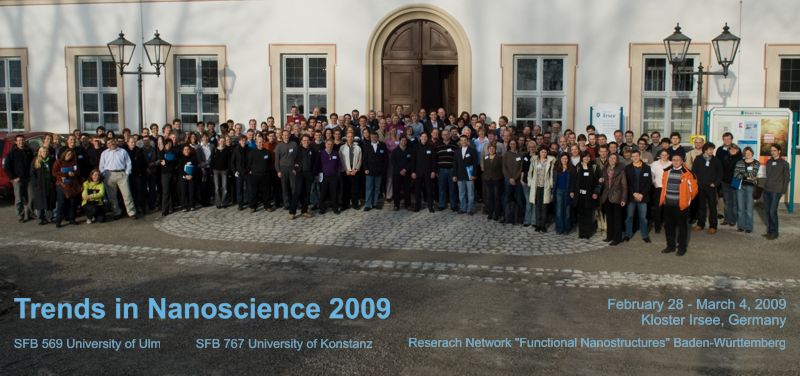Trends in Nanoscience 2009
The International Symposium Trends in Nanoscience was held this year for the third time, again at the Monastery of Irsee, Bavaria. It was jointly organized by the Collaborative Research Centers SFB 767 in Konstanz and SFB 569 in Ulm. The aim of this meeting bringing together scientists in the field of nanotechnology and stimulating vivid exchange about the current trends and ideas in this field was fully achieved. The symposium is of interdisciplinary character with most attendees being physicists or chemists reflecting the different approaches for e.g. the preparation of nanostructures. Applications of such structures are in medicine, information technology and the various fields of engineering. In addition to experimental investigations the theoretical understanding of nanostructures was an important subject.
The program consisted of invited talks by internationally renowned experts and junior researchers from the Collaborative Research Centers at Ulm and Konstanz. The main topics were molecular electronics, magnetic nanostructures, the properties of clusters and quantum dots, nanochemistry, self-assembly of nanostructures, biomimetic nanostructures, nanooptical effects and mechanical properties of nanostructures.
What are now the trends in nanoscience? One aspect are the various methods for the preparation of nanostructures with tailored properties by means of chemical synthesis, which is making remarkable progress and opens up completely new possibilities. This progress becomes obvious when comparing the presentations of this meeting with the previous ones at Trends in Nanoscience 2007. In addition, new materials are appearing which in combination with nanostructuring provide new potentials e.g. in microelectronics. A current example are individual layers of graphite, so-called graphene, which display unforeseen electronic properties. Another example are mechanical resonators with dimensions in the nanometre range. They can be used as detectors with outstanding sensitivity, since a few molecules are sufficient to shift the resonance frequency of these small structures. Impressive also the now possible control of photons applying opto-mechanical devices or fine-tuned antenna arrays. Similar impressive the progress, both from an experimental as well from a theoretical point of view, which became visible by the sessions related to elastic and inelastic tunneling.
At the end of the meeting, the 180 participants gave a warm applause to the organizers: on the Konstanz side Wolfgang Belzig, Johannes Boneberg, Rudolf Bratschitsch, Letizia Bruscaglioni, Paul Leiderer, Elke Scheer; Andreas Zumbusch and from Ulm Peter Bäuerle, Jürgen Behm, Gabriele Dinger, Axel Groß, Birgit Körner, and Paul Ziemann. Further support came via the Baden-Württemberg Network of Competence Functional Nanostructures represented by Thomas Schimmel (TU Karlsruhe). An excellent program was also offered for the non-scientific part of the Symposium by Johannes Boneberg: an excursion to the Castles of Neuschwanstein or Hohenschwangau, an organ concert in the monastery church of Irsee, and the concert of the quintet brass pur.

